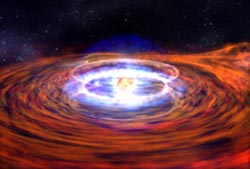Scientists find black hole’s ’point of no return’

Animation of a neutron star X-ray burst. Credit: NASA/Dana Berry
MIT/Harvard work reported at American Astronomical Society
Scientists have found new evidence that black holes are performing the disappearing acts for which they are known.
A team from MIT and Harvard has found that a certain type of X-ray explosion common on neutron stars is never seen around their black hole cousins, as if the gas that fuels these explosions has vanished into a void.
This is strong evidence, the team said, for the existence of a theoretical border around a black hole called an event horizon, a point from beyond which nothing, not even light, can escape.
Ron Remillard of the Kavli Institute for Astrophysics and Space Research at MIT led the analysis and is discussing his team’s result Jan. 9 at a press conference at the 207th meeting of the American Astronomical Society in Washington, D.C. His colleagues are Dacheng Lin of MIT and Randall Cooper and Ramesh Narayan of the Harvard-Smithsonian Center for Astrophysics in Cambridge.
The scientists studied a complete sample of transient X-ray sources detected with NASA’s Rossi X-ray Timing Explorer during the last nine years. They detected 135 X-ray bursts from the 13 sources believed to be neutron stars, but none from the 18 suspected black holes.
Gas released by a nearby star can accumulate on the hard surface of a neutron star, and it will eventually erupt in a thermonuclear explosion. The more massive compact objects in this study suspected of being black holes appeared to have no surface. Gas falling toward the black hole seems to disappear.
“Event horizons are invisible by definition, so it seems impossible to prove their existence,” said Remillard. “Yet by looking at dense objects that pull in gas, we can infer whether that gas crashes and accumulates onto a hard surface or just quietly vanishes. For the group of suspected black holes we studied, there is a complete absence of surface explosions called X-ray bursts.”
A black hole forms when a very massive star runs out of fuel. Without energy to support its mass, the star implodes. If the star is more than 25 times more massive than our sun, the core will collapse to a point of infinite density with no surface. Within a boundary of about 50 miles from the black hole center, gravity is so strong that not even light can escape its pull. This boundary is the theoretical event horizon.
Stars of about 10 to 25 solar masses will collapse into compact spheres about 10 miles across, called neutron stars. These objects have a hard surface and no event horizon.
Black holes and their neutron star cousins are sometimes located in binary systems, orbiting a relatively normal star companion. Gas from these stars, lured by strong gravity, can flow toward the compact object periodically. This process, called accretion, releases large amounts of energy, predominantly in the form of X-rays.
Gas can accumulate on a neutron star surface, and when conditions are ripe, the gas will ignite in a thermonuclear explosion that is visible as a one-minute event called a Type I X-ray burst. The suspected black holes — that is, the more massive types of compact objects in this study — behave as if they have no surface and are located behind event horizons.
The idea of using the absence of X-ray bursts to confirm the presence of event horizons in black holes was proposed in 2002 by Harvard’s Narayan and Jeremy Heyl of the University of British Columbia in Vancouver.
The Rossi Explorer, launched on Dec. 30, 1995, is operated by NASA Goddard Space Flight Center in Greenbelt, Md.
Media Contact
All latest news from the category: Physics and Astronomy
This area deals with the fundamental laws and building blocks of nature and how they interact, the properties and the behavior of matter, and research into space and time and their structures.
innovations-report provides in-depth reports and articles on subjects such as astrophysics, laser technologies, nuclear, quantum, particle and solid-state physics, nanotechnologies, planetary research and findings (Mars, Venus) and developments related to the Hubble Telescope.
Newest articles

High-energy-density aqueous battery based on halogen multi-electron transfer
Traditional non-aqueous lithium-ion batteries have a high energy density, but their safety is compromised due to the flammable organic electrolytes they utilize. Aqueous batteries use water as the solvent for…

First-ever combined heart pump and pig kidney transplant
…gives new hope to patient with terminal illness. Surgeons at NYU Langone Health performed the first-ever combined mechanical heart pump and gene-edited pig kidney transplant surgery in a 54-year-old woman…

Biophysics: Testing how well biomarkers work
LMU researchers have developed a method to determine how reliably target proteins can be labeled using super-resolution fluorescence microscopy. Modern microscopy techniques make it possible to examine the inner workings…





















